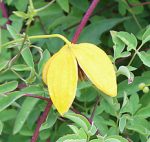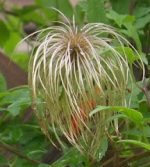 Also called orange-peel clematis, Russian virgin’s bower, and tube-flowered clematis, this herbaceous climbing vine is native to forests, open areas, and riparian area in central to northwestern China. It is a member of the buttercup family, Ranunculaceae, that also includes delphinium, columbine and hellebore. Plants grow up to 15′ long and climbs if suitable structures are nearby or sprawls on the ground with the appearance of a shrub. The slightly pubescent stems carry pinnate to bipinnate lanceolate leaves with oblong leaflets that are up to 2.33″ long and have acute tips and finely serrated margins. From mid- summer into fall bright yellow bell-shaped flowers appear and open to 3-4″ across before giving way to feathery, whispy seedheads that are ornamental and easily dried for use in arrangements. Plants are attractive growing on shrubs as well as walls, trellis, and arbors. The genus name, Clematis, is the ancient Greek word klematis meaning a climbing plant. The specific epithet, tangutica, honors the Tangut people who live in one of the areas where the plant is native.
Also called orange-peel clematis, Russian virgin’s bower, and tube-flowered clematis, this herbaceous climbing vine is native to forests, open areas, and riparian area in central to northwestern China. It is a member of the buttercup family, Ranunculaceae, that also includes delphinium, columbine and hellebore. Plants grow up to 15′ long and climbs if suitable structures are nearby or sprawls on the ground with the appearance of a shrub. The slightly pubescent stems carry pinnate to bipinnate lanceolate leaves with oblong leaflets that are up to 2.33″ long and have acute tips and finely serrated margins. From mid- summer into fall bright yellow bell-shaped flowers appear and open to 3-4″ across before giving way to feathery, whispy seedheads that are ornamental and easily dried for use in arrangements. Plants are attractive growing on shrubs as well as walls, trellis, and arbors. The genus name, Clematis, is the ancient Greek word klematis meaning a climbing plant. The specific epithet, tangutica, honors the Tangut people who live in one of the areas where the plant is native.
 Type: Herbaceous climbing vine
Type: Herbaceous climbing vine
Bloom: Bright yellow, bell-shaped flowers from mid summer into fall; ornamental seedheads.
Size: 12-15′ H x 6-8′ W
Light: Full sun but roots in the shade
Soil: Fertile, medium moist, well-drained. Roots must be kept cool which can be done by growing vegetation or placing a rock over them.
Hardiness: Zones 5-9
Care: Fertilize with a balanced fertilizer during the growing season. Bloom occurs on current year’s growth so prune back to 8-12″ above ground level to strong leaf buds in late winter to early spring at least every 4-5 years to renew vigor. Less severe pruning in intervening years results in earlier and longer bloom.
Pests and Diseases: Wilt, powdery mildew, rust, aphids, earwigs, scale, slugs, snails, vine weevils
Propagation: Seed, softwood cuttings
Companion Plants: Climbing roses, dwarf Japanese maple, ‘Black Lace’ elderberry, purple leaf smoke bush